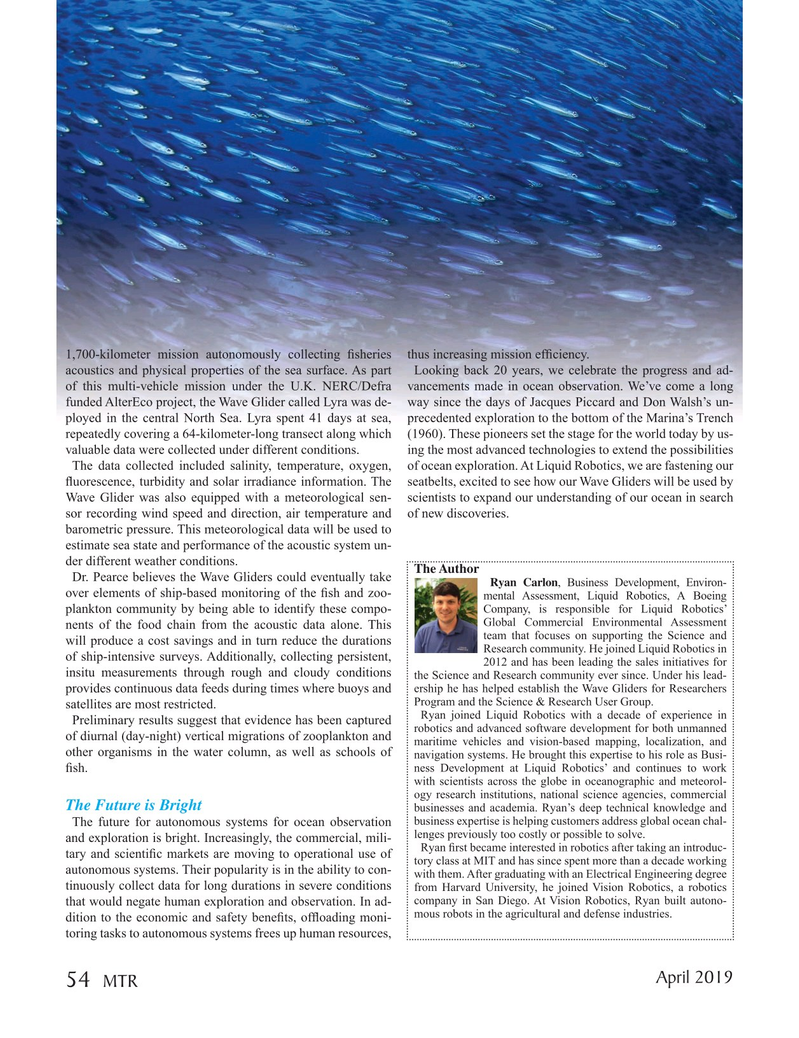
Page 54: of Marine Technology Magazine (April 2019)
Ocean Energy: Oil, Wind & Tidal
Read this page in Pdf, Flash or Html5 edition of April 2019 Marine Technology Magazine
1,700-kilometer mission autonomously collecting ? sheries thus increasing mission ef? ciency. acoustics and physical properties of the sea surface. As part Looking back 20 years, we celebrate the progress and ad- of this multi-vehicle mission under the U.K. NERC/Defra vancements made in ocean observation. We’ve come a long funded AlterEco project, the Wave Glider called Lyra was de- way since the days of Jacques Piccard and Don Walsh’s un- ployed in the central North Sea. Lyra spent 41 days at sea, precedented exploration to the bottom of the Marina’s Trench repeatedly covering a 64-kilometer-long transect along which (1960). These pioneers set the stage for the world today by us- valuable data were collected under different conditions. ing the most advanced technologies to extend the possibilities
The data collected included salinity, temperature, oxygen, of ocean exploration. At Liquid Robotics, we are fastening our ? uorescence, turbidity and solar irradiance information. The seatbelts, excited to see how our Wave Gliders will be used by
Wave Glider was also equipped with a meteorological sen- scientists to expand our understanding of our ocean in search sor recording wind speed and direction, air temperature and of new discoveries.
barometric pressure. This meteorological data will be used to estimate sea state and performance of the acoustic system un- der different weather conditions.
The Author
Dr. Pearce believes the Wave Gliders could eventually take
Ryan Carlon, Business Development, Environ- over elements of ship-based monitoring of the ? sh and zoo- mental Assessment, Liquid Robotics, A Boeing
Company, is responsible for Liquid Robotics’ plankton community by being able to identify these compo-
Global Commercial Environmental Assessment nents of the food chain from the acoustic data alone. This team that focuses on supporting the Science and will produce a cost savings and in turn reduce the durations
Research community. He joined Liquid Robotics in of ship-intensive surveys. Additionally, collecting persistent, 2012 and has been leading the sales initiatives for insitu measurements through rough and cloudy conditions the Science and Research community ever since. Under his lead- ership he has helped establish the Wave Gliders for Researchers provides continuous data feeds during times where buoys and
Program and the Science & Research User Group. satellites are most restricted.
Ryan joined Liquid Robotics with a decade of experience in
Preliminary results suggest that evidence has been captured robotics and advanced software development for both unmanned of diurnal (day-night) vertical migrations of zooplankton and maritime vehicles and vision-based mapping, localization, and other organisms in the water column, as well as schools of navigation systems. He brought this expertise to his role as Busi- ness Development at Liquid Robotics’ and continues to work ? sh.
with scientists across the globe in oceanographic and meteorol- ogy research institutions, national science agencies, commercial
The Future is Bright businesses and academia. Ryan’s deep technical knowledge and business expertise is helping customers address global ocean chal-
The future for autonomous systems for ocean observation lenges previously too costly or possible to solve.
and exploration is bright. Increasingly, the commercial, mili-
Ryan ? rst became interested in robotics after taking an introduc- tary and scienti? c markets are moving to operational use of tory class at MIT and has since spent more than a decade working autonomous systems. Their popularity is in the ability to con- with them. After graduating with an Electrical Engineering degree tinuously collect data for long durations in severe conditions from Harvard University, he joined Vision Robotics, a robotics company in San Diego. At Vision Robotics, Ryan built autono- that would negate human exploration and observation. In ad- mous robots in the agricultural and defense industries. dition to the economic and safety bene? ts, of? oading moni- toring tasks to autonomous systems frees up human resources,
April 2019 54
MTR
MTR #3 (50-63).indd 54 4/11/2019 2:38:00 PM

 53
53

 55
55
